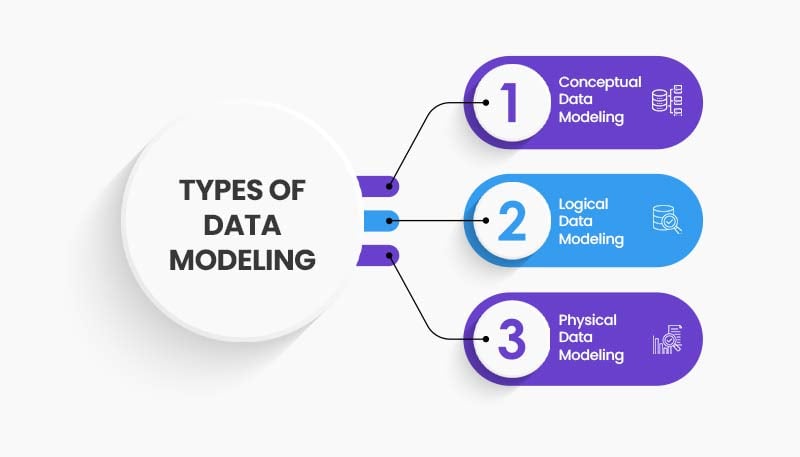Big Data and Analytics | 25 Aug 2023 | 16 min
Data Modeling: Overview, Types, Standards, and Best Practices

In the rapidly evolving world, we live in, data plays a crucial role in guiding businesses toward success. However, extracting, organizing, and visualizing the vast amount of data that businesses receive can be quite challenging. Fortunately, there is a solution for you: data modeling. Data modeling enables you to:
Seize the opportunity to propel your business to new heights of success.
To do so, explore the intricacies of data modeling, including its various types, tools, and best practices further.
Data modeling is the process of creating a conceptual representation of data structures, relationships, and rules within an organization. It involves identifying and defining the data entities, attributes, and their interconnections.
Once the data gets organized, data visualization presents the modeled data in a visual format for better understanding and analysis.
By creating a blueprint of the data ecosystem, data modeling enhances data integrity, accuracy, and consistency. It serves as a foundation for database design, application development, and data analysis.
Ultimately, data modeling helps organizations gain insights, optimize processes, and leverage data effectively to drive business success.
Data modeling has evolved significantly over the years, reaching key milestones in its progression.
Data modeling includes various types, each offering unique benefits for business growth. Now, let’s delve into this intriguing realm and explore the different data modeling types in detail.
Data modeling encompasses various techniques tailored to address specific needs. Let’s delve deeper into the topic by exploring three common types of data modeling:

1. Conceptual Data Modeling: This type focuses on high-level abstractions. It identifies the:
It helps stakeholders gain a holistic understanding of the data requirements without venturing into technical specifics.
2. Logical Data Modeling: Logical models provide a detailed representation of data structures, emphasizing relationships between entities. They are used to:
3. Physical Data Modeling: Physical models translate the logical design into a database-specific implementation. They consider factors such as:
This helps database administrators and developers in creating and maintaining efficient database systems.
Below, you’ll find an overview of the specific standards followed by each of the data modeling types.
Data modeling standards can be defined as a set of guidelines and conventions that confirm how data is structured, organized, and represented in a database system. It outlines the rules for creating entities, attributes, relationships, and constraints. These standards serve as a framework for designing, documenting, and maintaining data models for effective data management and system development.
There are 3 types of data modeling standards:
The 3 data modeling standards mentioned above, provide several benefits. Such as:
To clarify, data modeling types refer to the different approaches and methodologies used to create data models whereas data models themselves represent the structured representations of information.
Don’t confuse the two!
Here are the types of data models:
Data modeling has been around for decades and has proven to be an essential practice in various industries. From finance to healthcare and retail to manufacturing, organizations across diverse sectors leverage data modeling to unlock the full potential of their data.
Let’s walk you through the various advantages of data modeling next.
Implementing effective data modeling can bring several advantages to organizations, such as:
1. Improved Data Quality: It ensures accurate, consistent, and reliable data by eliminating redundancies and inconsistencies.
2. Enhanced Decision-Making: A well-designed data model enables easy analysis and interpretation of data, supporting informed decision-making.
3. Efficient System Development: Data models streamline the development process by identifying data requirements. Thus, reducing time and costs.
4. Scalability and Flexibility: Well-structured data models allow for future growth and adaptability. It integrates new systems easily without disruption.
5. Collaboration and Communication: Data models serve as a common language. They facilitate effective collaboration and shared understanding among stakeholders, developers, and administrators.
To unlock these advantages, it is essential to follow a data modeling process. Keep reading as we dive into the technique.
Data modeling entails going through these steps:
1. Identify Requirements: Understand business needs and define project goals by engaging stakeholders and subject matter experts.
2. Conceptual Modeling: Create a high-level model representing entities, relationships, and attributes without technical details.
3. Logical Modeling: Develop detailed model mapping entities, attributes, and relationships.
4. Normalization: Eliminate redundancy and ensure data integrity through normalization techniques.
5. Physical Modeling: Optimize the logical model for a specific DBMS, considering performance and indexing strategies.
6. Validation and Iteration: Review and gather feedback on the model, iteratively addressing issues and requirements.
7. Documentation: Document the purpose, entities, relationships, and attributes of the data model.
8. Implementation: Translate the data model into a physical database schema, tables, and relationships.
Well, along with the process, it’s important to recognize the value of certain tools that are essential for executing it effectively. Let’s get to know these tools in the next section.
Here are the top 5 tools for data modeling in 2023:
Having equipped yourself with top-notch tools, it’s essential to familiarize yourself with some best practices, which can serve as the final layer of armour for your business.
Here are some of the best practices for data modeling:
Therefore, as data continues to grow in volume, organizations that prioritize data modeling and business intelligence will be better equipped to make well-informed decisions.
Nitor Infotech’s expertise in data management solutions positions them as a valuable partner for organizations looking to excel in the digital age. By leveraging our knowledge and experience, businesses can confidently embrace scalable data management systems and implement strong data governance practices.
With our support and guidance, organizations can navigate the complex data landscape, foster innovation, and ultimately achieve success in this ever-evolving digital age.
Also, Send us an email with your thoughts on Data Modeling.

we'll keep you in the loop with everything that's trending in the tech world.
